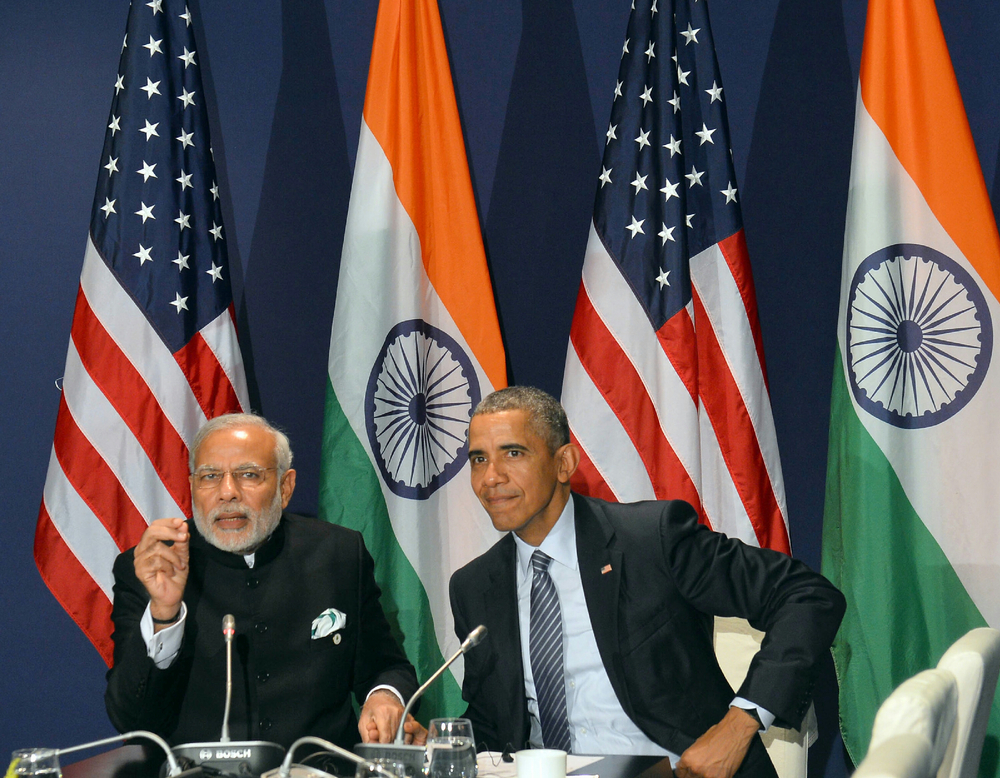Obama, Modi Agree to “Concrete Progress This Year” to Reduce HFCs Under Montreal Protocol

Obama continues leader-level campaign to eliminate these super climate pollutants
Deadly air pollution another climate target
25 January 2015 - India's Prime Minister Narendra Modi and President Barack Obama issued a joint statement today agreeing to make “concrete progress in the Montreal Protocol this year,” building on their prior understandings to phasedown of HFCs at their September 2014 meeting. (See para. 45.)
“Today’s joint HFC agreement shows that President Obama is not letting up on his leader-level campaign to eliminate one of the six main greenhouse gases this year, using the world’s most effective and efficient environmental treaty,” said Durwood Zaelke, President of the Institute of Governance & Sustainable Development. “Today’s agreement with Prime Minister Modi is a critical step forward on the climate front, and complements a similar set of agreements President Obama negotiated with President Xi of China last year.”
John Podesta, Obama’s top climate advisor, confirmed in the Indian press that the President has the “‘full commitment’ of the Prime Minister to move forward on phasing down HFCs according to the Montreal Protocol.”
“With Prime Minister Modi’s support and leadership, it is now possible to conclude an agreement this year to eliminate HFCs under the Montreal Protocol,” Zaelke added. “This will provide powerful political momentum for a successful climate agreement in Paris in December.”
Under their September 2014 U.S.-India Joint Statement, which the two leaders reaffirmed today, they “recognized the need to use the institutions and expertise of the Montreal Protocol to reduce consumption and production of HFCs, while continuing to report and account for quantities reduced under the UNFCCC.”
The September HFC agreement was part of a broader energy and climate package, as is today’s agreement, where the United States will provide support to advance India’s capacity to address climate change and shift to a low-carbon and climate-resistant energy economy, while improving air quality and energy efficiency. This will include making $1 billion available to finance renewable energy and new research and development institutes for developing clean energy in India.
Under today’s agreement, the U.S. also will be helping India improve the efficiency of its air conditioning sector, which uses 40 to 60% of India’s electricity in hot periods, often contributing to blackouts on the grid. Historically, when the Montreal Protocol has mandated a phase out of a refrigerant like HFCs, A/C manufacturers have used the opportunity to improve the energy efficiency of their products to lower cost and improve customer satisfaction. Improving A/C efficiency in India can save enough electricity to avoid building 120 medium-sized power plants by 2030, according to Lawrence Berkeley energy lab in California.
Eliminating HFCs with high global warming potential will avoid up to 0.5°C of warming by 2100. If done quickly, phasing out HFCs can avoid up to 200 billion tones of CO2-equivalent. This is more than 10% of the climate mitigation needed to stay below the 2°C guardrail for limiting warming above pre-Industrial levels. If the CO2 mitigation from improvement in appliance energy efficiency is added, the total climate mitigation could double.
“The Montreal Protocol is widely regarded as the most effective climate treaty ever created, and it’s on track to eliminate one of the main climate pollutants as a warm up to the UN climate agreement in Paris this December,” Zaelke stated.
Today’s agreement between Modi and Obama also included cooperation on air pollution, “to reduce … exposure to harmful levels of air pollution, and … implement corrective strategies for improving Ambient Air Quality in the cities keeping in view health and climate change co-benefits of these strategies.” (See para. 44 (iv).)
“Cutting black carbon soot and ground level ozone air pollution globally can cut the rate of climate change in half through mid-century,” Zaelke stated. “Prime Minister Modi can now join President Obama and President Xi of China in this key strategy, and in the process save millions of lives in India while improving crop yields enough to feed 94 million people a year in India.” See The Path to a Safe Climate Goes Through India, by Zaelke & Ramanathan.
The White House Fact Sheet: U.S. and India Climate and Clean Energy Cooperation is here.
IGSD’s HFC Primer is here.